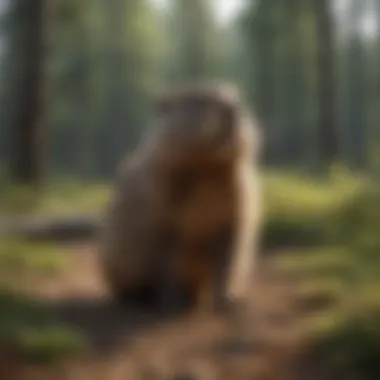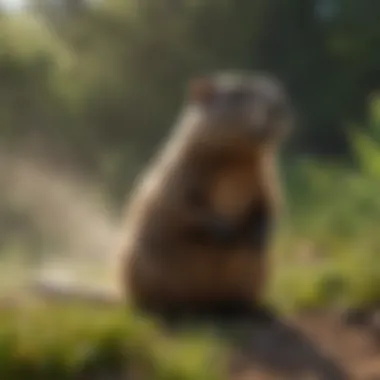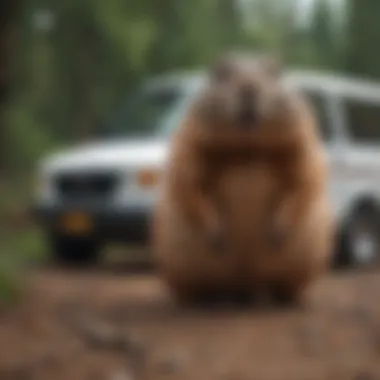Effective Groundhog Pest Removal Methods: Comprehensive Guide


Groundhog pests can wreak havoc on your property, causing damage to gardens, lawns, and structures. This guide delves into various techniques to effectively tackle and eliminate groundhog infestations. From preventative measures to humane removal strategies, this comprehensive overview equips you with the knowledge needed to safeguard your property from these troublesome pests.
Current Challenges in Groundhog Pest Control
The current state of groundhog infestations poses significant challenges for property owners. As these pests burrow underground, they can cause structural damage and disrupt the landscaping. Identifying these challenges is crucial in developing effective pest control strategies to manage and eradicate groundhog populations in a sustainable manner.
Sustainable Approaches to Groundhog Pest Management
Exploring sustainable methods for groundhog pest control is imperative to address environmental concerns while effectively managing infestations. Integrated pest management techniques, such as exclusion methods and habitat modification, provide ecologically-friendly solutions for mitigating groundhog issues without harming the ecosystem.
Impact of Groundhog Infestations on Ecosystems and Communities
The presence of groundhog pests can have a profound impact on ecosystems and communities. By disrupting the natural balance and causing property damage, groundhogs can spur conflicts between humans and wildlife. Understanding the importance of proactive pest management is key to preserving biodiversity and fostering harmonious coexistence between humans and wildlife.
Understanding Groundhog Behavior
Understanding groundhog behavior is crucial in effectively managing groundhog infestations on your property. By delving into the habits and preferences of these rodents, you can implement targeted strategies for pest control. Groundhogs are known for their dietary habits, burrowing tendencies, and preferred habitats, which influence their presence and impact on the surrounding environment. By understanding these behavioral aspects, property owners can proactively address groundhog issues before they escalate.
Groundhog Habits and Preferences
Dietary habits
Groundhogs primarily feed on vegetation, including grasses, berries, and agricultural crops. Their predominantly herbivorous diet distinguishes them as significant agricultural pests. Understanding their dietary preferences helps in devising effective repellents and deterring methods. While their feeding habits aid in their survival, they can cause substantial damage to crops and ornamental plants.
Burrowing tendencies
Groundhogs are skilled burrowers, creating extensive underground tunnels for shelter and hibernation. Their burrowing behavior poses risks to property foundations, gardens, and landscapes. Recognizing their burrowing tendencies allows property owners to identify potential burrow locations and take preventive measures to protect their land from structural damage and instability. Despite their impressive digging skills, groundhog burrows can undermine the integrity of structures and pose safety hazards.
Preferred habitats
Groundhogs prefer open areas with easy access to vegetation for foraging. They tend to inhabit fields, meadows, and the outskirts of forests where food sources are abundant. Understanding their attraction to specific habitats enables property owners to modify landscape features to deter groundhog activity. By creating barriers and removing enticing elements from the surrounding environment, individuals can reduce the likelihood of groundhog intrusion and minimize associated property damage.


Signs of Groundhog Presence
Damage to property
Groundhogs inflict noticeable damage to landscapes by chewing on plants, creating burrow openings, and excavating soil. The destruction caused by their feeding and burrowing activities can impact agricultural productivity and landscape aesthetics. Recognizing signs of property damage attributed to groundhogs allows for prompt intervention to prevent further deterioration and mitigate financial losses.
Tracks and droppings
Monitoring groundhog tracks and droppings provides definitive evidence of their presence on the property. Their distinctive footprints and fecal droppings aid in tracking groundhog movements and determining high-traffic areas. By identifying these signs, property owners can strategically place deterrents and traps to control groundhog populations effectively.
Visual sightings
Visual sightings of groundhogs near gardens, fields, or properties indicate active infestations requiring immediate attention. Observing groundhogs during daylight hours highlights their feeding patterns and favorite locations. Regular surveillance of visual sightings aids in implementing timely pest management measures, such as installing repellents or seeking professional assistance for removal and relocation.
Preventative Measures
Preventative measures play a crucial role in effective groundhog pest removal. By implementing proactive strategies, property owners can mitigate the risk of groundhog infestations. These methods not only safeguard the property but also contribute to environmental conservation efforts. Ensuring the integration of preventative measures in groundhog pest management plans is fundamental for long-term success and sustainable pest control practices.
Securing Property
When it comes to securing property against groundhog intrusions, fencing options emerge as a primary line of defense. Fences act as physical barriers, preventing groundhogs from accessing vulnerable areas. The selection of suitable fencing materials and designs significantly influences the efficacy of this method. Robust and properly installed fences effectively deter groundhogs, reducing the likelihood of property damage. While fencing options require initial investment and maintenance, their durability and effectiveness make them a worthwhile choice for property protection.
Vegetation Management
Vegetation management holds a vital role in preventing groundhog infestations. By controlling plant growth around the property, individuals can eliminate hiding spots and food sources for groundhogs. Trimmed vegetation reduces the attractiveness of the area to these pests, encouraging them to seek shelter elsewhere. Incorporating regular maintenance practices such as pruning and mowing can create a more inhospitable environment for groundhogs, decreasing the likelihood of infestations. While vegetation management demands ongoing effort, its positive impact on pest prevention justifies the attention and resources invested.
Eliminating Attraction Factors
To further enhance groundhog pest removal efforts, addressing attraction factors like trash management is essential. Proper waste disposal practices discourage groundhog presence by removing potential food sources. Securing trash cans and adopting secure waste management practices minimize the appeal of the property to groundhogs. Regular waste audits and effective waste disposal routines significantly reduce the risk of attracting these pests. While trash management requires diligence and consistency, its impact on deterring groundhogs is invaluable.
Food Sources Removal
The removal of accessible food sources is paramount in deterring groundhog infestations. By eliminating sources of food such as pet food remnants and unsecured garbage, property owners can disrupt the food chain of groundhogs. Implementing strategies to restrict access to food supplies minimizes the incentive for groundhogs to inhabit the area. Consistent monitoring of potential food attractants and prompt removal of such items are key practices in effective pest management. While food sources removal demands vigilance, its significance in deterring groundhogs justifies the attention and efforts devoted to this aspect.


Humane Removal Techniques
Humane removal techniques are a pivotal aspect to consider when addressing groundhog pest infestations. These methods prioritize the safe and ethical relocation of the animals without causing harm or distress. By employing humane practices, individuals can effectively manage groundhog populations while respecting the importance of wildlife conservation and coexistence. The utilization of humane removal techniques reflects a conscientious approach to pest control and promotes harmonious interactions between humans and the natural environment.
Live Trapping Methods
Choosing the right trap
When discussing live trapping methods for groundhog removal, the selection of the appropriate trap plays a fundamental role in the success of the endeavor. The choice of trap should align with the size and habits of groundhogs to ensure a humane and efficient capture process. Live traps offer a non-lethal means of capturing groundhogs unharmed, allowing for their subsequent relocation. Their design typically incorporates mechanisms that securely contain the animal without causing injury, making them a popular and humane choice for pest removal. Live traps provide a safe and effective means of controlling groundhog populations while minimizing stress and harm to the animals being captured. Their versatility and ease of use make them a valuable tool in implementing humane removal strategies.
Baiting strategies
In the realm of groundhog removal, baiting strategies play a crucial role in enhancing the efficacy of live trapping methods. By strategically selecting baits that appeal to groundhogs' dietary preferences, individuals can increase the likelihood of successfully attracting the animals into the traps. Popular bait options include fresh fruits and vegetables, which are known to entice groundhogs due to their natural feeding habits. Baiting strategies help in luring groundhogs into traps, facilitating their humane capture for later relocation. However, it is essential to place baits carefully within the traps to ensure that the animals are encouraged to enter while minimizing the risk of trap aversion. Thoughtful consideration of baiting techniques enhances the effectiveness of live trapping methods, contributing to a more streamlined and successful pest removal process.
Relocation Guidelines
Legal considerations
When undertaking groundhog relocation, adhering to legal considerations is crucial to ensure compliance with local regulations and wildlife protection laws. Before relocating groundhogs, individuals must familiarize themselves with pertinent legislation governing the trapping and transportation of wildlife. This includes obtaining any necessary permits or licenses required for relocating animals, as well as understanding specific guidelines relating to humane capture and relocation practices. By prioritizing legal considerations in the relocation process, individuals demonstrate a commitment to ethical and responsible pest control practices that align with conservation efforts and wildlife protection initiatives.
Safe release practices
The safe release of captured groundhogs is an imperative component of humane relocation efforts. By practicing safe release techniques, individuals can ensure that the animals are reintroduced into their natural habitats without harm or detriment to their well-being. Safe release practices involve selecting suitable release sites that offer appropriate shelter, food sources, and environmental conditions to support the groundhog's survival post-release. Additionally, releasing groundhogs during favorable weather conditions and times of the day can enhance their chances of acclimatizing successfully to their new surroundings. By adopting safe release practices, individuals contribute to the welfare and preservation of groundhog populations while upholding ethical standards of wildlife management.
Professional Pest Control Services
When it comes to effectively dealing with groundhog infestations, considering professional pest control services can make a significant difference. These experts bring a wealth of knowledge and experience to the table, which can be invaluable in handling complex pest issues. By entrusting the task to professionals, property owners can benefit from specialized techniques and strategies tailored to address groundhog problems specifically. The application of professional-grade equipment and methods enhances the effectiveness of pest removal, ensuring a more thorough and long-lasting solution.
Benefits of Hiring Experts
Expertise and Experience


One of the undeniable advantages of opting for professional pest control services is the expertise and experience these professionals bring to the field. Their in-depth understanding of groundhog behavior and biology enables them to devise customized and proactive pest management plans. The proficiency gained through years of handling similar cases equips them with the necessary skills to accurately assess the infestation severity and implement targeted eradication methods. The hands-on experience of dealing with diverse pest scenarios ensures that they can deliver efficient solutions tailored to the specific needs of each property owner.
Long-term Solutions
Professional pest control services also offer the advantage of long-term solutions to groundhog problems. Rather than providing temporary fixes, these experts focus on addressing the root causes of infestations to prevent future recurrences. By employing sustainable pest control practices, such as comprehensive property inspections and habitat modifications, they aim to create an inhospitable environment for groundhogs. The emphasis on preventive measures and proactive strategies not only resolves the immediate issue but also safeguards the property against potential pest invasions in the long run.
Choosing the Right Service Provider
Licenses and Certifications
When selecting a pest control service provider, verifying their licenses and certifications is crucial. Licensed professionals adhere to industry standards and regulations, ensuring that their practices align with legal requirements. Certification indicates that the service provider has undergone training and possesses the necessary qualifications to handle pest control operations effectively. By choosing a licensed and certified provider, property owners can trust in the expertise and credibility of the professionals, promoting confidence in the service's quality and reliability.
Customer Reviews
Another essential aspect to consider when choosing a pest control service provider is the feedback and experiences shared by past customers. Customer reviews offer valuable insights into the provider's performance, reliability, and customer satisfaction levels. Positive reviews indicating successful pest removal outcomes, prompt service delivery, and effective communication signify a provider's dedication to customer service excellence. Conversely, negative reviews might highlight areas of improvement or potential red flags to consider, assisting property owners in making informed decisions when selecting a service provider.
DIY Remedies and Deterrents
DIY Remedies and Deterrents play a crucial role in the realm of effective groundhog pest removal. Homeowners and property managers often resort to these methods due to their accessibility, cost-effectiveness, and eco-friendliness. Implementing DIY solutions empowers individuals to take proactive steps in managing groundhog infestations on their premises, without solely relying on professional services. By delving into the world of DIY Remedies and Deterrents, one can gain a deeper understanding of natural alternatives that align with environmentally conscious practices.
Natural Repellents
Pepper-based Sprays
Pepper-based sprays stand out as a cornerstone of natural repellents in the battle against groundhog invasions. With their pungent aroma and capsaicin content, these sprays act as potent deterrents, effectively discouraging groundhogs from entering specific areas. The key characteristic of pepper-based sprays lies in their non-toxic nature, making them safe for the environment and nearby wildlife. Homeowners prefer these sprays for their efficacy and non-harmful attributes, ensuring a sustainable approach to pest control. While the unique feature of pepper-based sprays lies in their ability to deter pests organically, it's essential to note their limited effectiveness during heavy rain spells.
Predator Urine
Predator urine emerges as a formidable ally in the quest for repelling groundhogs naturally. Its distinct odor triggers a primal fear response in groundhogs, signaling the presence of potential predators in the vicinity. This key characteristic of predator urine capitalizes on animals' innate instincts for survival, leading groundhogs to avoid areas marked with this deterrent. Predator urine gains popularity for its natural composition and biodegradability, ensuring minimal impact on the ecosystem. While the unique feature of predator urine lies in its primal approach to deterring pests, its potential disadvantages encompass varying effectiveness based on individual groundhog sensitivities.
Behavior Modification Techniques
Sound Deterrents
Sound deterrents stand at the forefront of behavior modification techniques, leveraging auditory stimuli to influence groundhog behavior. Emitting high-frequency sounds intolerable to groundhogs, these devices disrupt their habitation patterns, prompting them to seek quieter environments. The key characteristic of sound deterrents lies in their non-invasive nature, offering a humane solution to deterring pests without causing physical harm. Homeowners gravitate towards these deterrents for their efficiency in warding off unwanted wildlife, ensuring a peaceful coexistence between humans and groundhogs. Despite the unique feature of sound deterrents in providing a sound-based deterrent, their effectiveness may diminish over time as groundhogs adapt to the auditory cues.
Visual Scare Tactics
Visual scare tactics serve as an innovative approach to modifying groundhog behavior through visual stimuli. By strategically placing decoy predators or reflective objects in infested areas, homeowners create visual disturbances that instill a sense of unease in groundhogs. The key characteristic of visual scare tactics lies in their non-intrusive design, offering a hands-off method of deterring pests without physical contact. Users appreciate these tactics for their creativity and harmless nature, fostering a harmonious environment between humans and wildlife. While the unique feature of visual scare tactics lies in their visually stimulating properties, their effectiveness may diminish over time as groundhogs acclimate to the perceived threats.



